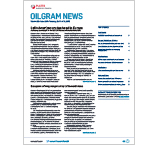S&P Global Offerings
Featured Topics
Featured Products
Events
S&P Global Offerings
Featured Topics
Featured Products
Events
S&P Global Offerings
Featured Topics
Featured Products
Events
S&P Global Offerings
Featured Topics
Featured Products
Events
Our Methodology
Methodology & Participation
Reference Tools
S&P Global
S&P Global Offerings
S&P Global
Research & Insights
Our Methodology
Methodology & Participation
Reference Tools
S&P Global
S&P Global Offerings
S&P Global
Research & Insights
11 Jan 2016 | 10:31 UTC — Insight Blog

Featuring Ashok Dutta
The oil industry had eight years of an energy friendly government in Canada and couldn’t get a single new export pipeline built.
Now, with newly elected Prime Minister Justin Trudeau keeping his campaign promise of banning tanker traffic off parts of Canada’s west coast, it put the already reeling industry further on its heels and could eventually force more production shut-ins and cuts in investment due to a lack of access to global crude markets.
The previous government, led by Prime Minister Stephen Harper, and industry put its eggs in the Keystone XL basket and in the end got sideswiped by the US government not approving Keystone XL while giving the nod to US crude exports. Apparently US shale development is less an environmental concern than Canadian oil sands.
Now the industry is pushing several new Canadian export pipelines, but has a new government to deal with that is seemingly tone-deaf to Canada’s oil industry challenges.
In mid-November, when Trudeau said an oil tanker ban would be implemented on the North Coast of British Columbia, it posed a major impediment to Enbridge’s proposed Northern Gateway pipeline. While the line already received regulatory approval from the National Energy Board, if a crude tanker ban is in place there would be no point in bringing crude oil to the coast, and no need for the pipeline. There are no solid plans for a refinery in the area.
Blog post continues below...
|
|
||||
| Request a free trial of: Oilgram News |  |
|||
 |
Oilgram News brings fast-breaking global petroleum and gas news to your desktop every day. Our extensive global network of correspondents report on supply and demand trends, corporate news, government actions, exploration, technology, and much more. | |||
 |
||||
|
|
||||
The dual pipeline is aimed at exporting 525,000 b/d of Western Canadian crude from Alberta to a deep water port at Kitimat, British Columbia, and was targeted for start in late 2017/early 2018. The pipeline will also import 193,000 b/d of condensate to flow in a reverse direction from the coast to Alberta’s oil sands producers. The ban was an election promise the Liberal Party made before elections last fall to save ecologically-sensitive areas, Canada’s Natural Resources Minister James Carr told reporters in Calgary in late November.
Work is already underway to develop a strategy to implement the ban, a Transport Canada spokesperson Natasha Gauthier said without indicating a timeline or the road map ahead.
She did not respond to pointed queries whether the ban would include condensate and LPG tankers and the LNG carriers that are expected to set sail from the ports of Kitimat and Prince Rupert from 2020 onward to navigate along the northern coast on their way to Asian markets.
If those products were included in the tanker ban, billions of dollars in projects would be at risk.
Extending ban southward imperils other projects
There is now talk of extending the ban farther south along the province’s coast and the transport minister has been asked to look into it, Carr said in November without elaborating.
A southern extension of the moratorium along the British Columbian coast would impact another major export pipeline project: the 890,000 b/d Kinder Morgan-backed Trans Mountain Expansion, for which an NEB ruling is due by May 20, 2016.
The expansion — which is already facing a two-year delay with a planned start-up now in fall 2019 — would allow an additional 29 Aframax crude tankers to load at Westridge in British Columbia and use existing shipping lanes from Port Metro Vancouver in the south coast to the Pacific Ocean, Kinder Morgan legal counsel Shawn Denstedt said recently at an NEB hearing in Calgary.
“It is pretty early to speculate what will happen [with the tanker ban],” Enbridge CEO Al Monaco said last month on a webcast. “We have heard the Prime Minister and federal Natural Resources Minister and we have also been told securing new markets is also an issue they will support.”
It will be difficult to secure new markets without new pipelines.
Another set of hurdles will soon emerge for Alberta’s oil producers with the federal government due to start a review of its regulatory process for approving crude oil pipelines, seek greater involvement of Aboriginal peoples and aim to reduce carbon emissions.
“A review of the approval process is in line with another election promise we made and will now be getting into a transition process with the NEB to take a close look at the existing procedures,” Carr said in late November.
“We are in the business of transparency, rather than guaranteeing approvals for pipelines. Our focus will be on a more robust oversight of the regulatory process and a thorough assessment and there will be a transition phase,” Carr said then.
If those changes were not enough for an industry on the ropes, the government is to soon unveil changes to its existing royalty structure.
Just as US politics doomed the Keystone XL pipeline, Canadian politics threatens more than that as election promises become reality. — Ashok Dutta